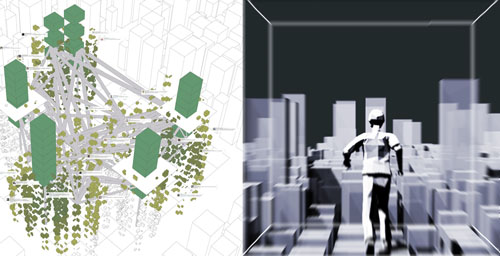THE TRANSFORMER

Life in the real-time adaptive, constantly changing city
In today’s cities and buildings, we see a growing invasion of ambient technologies. We got used to light turning on when we enter a room, traffic lights adapting during rush hour and autopilots steering jumbo jets. Even the smart fridge that orders food and turns on the oven while suggesting dinner receipts to you became reality and is being launched later this year.
In the Transformable City project, we take this development a step further. The city reacts physically. Buildings can move, expand or shrink. Public space can adapt to different requirements. Spaces can transform to your desires. Your apartment can fluently change from bedroom to bathroom, to lounge or sun deck or shrink and almost disappear if you are not home.
If such an adapting environment becomes reality, how does the user interact with a constantly changing, adapting city and it’s users. If your wall can change into a bed, a window, a bathroom – how do you tell your wall what you want? If the city can adapt to different needs of social interaction or quiet privacy, how does it ask the citizens what they want? How dynamic can the city react if different users have different desires? What images can we expect from a city, which is constantly re-made, re-build by it’s users?

We will explore these questions in three steps:
We will use Rhino and Grasshopper to model an interactive environment. The studio includes an introduction to both programs. The results of the tutorial will become part of the final installation at the end of the studio.
The interactive models will be extended with real sensors, which can inform the interactive model. We will use smartphones, iPads and various sensors for light, movement, sound or temperature to connect the real environment of the atelier with the virtual city you are modelling.
Based on the first exercises in interactive environments, scenarios will be developed: How could these principles be applied in the real city? What kind of transformation can we imagine? Would the city observe and measure the behaviour would it rely on active participation of its users? How would you interact with transformable rooms, buildings, streets and city scape? What new possibilities would it open up?
The scenarios are used to create a number of interactive installations. The models remain virtual, but are projected in a spatial arrangement. The sensors are connected to the installation. The transformable city reacts in real time to its visitors…
Kickoff: Tuesday the 18th of September, Room to be announced.
Exercise Type: E (Entwurf ohne integrierte Disziplin).
The studio is taught by Prof. Winy Maas in collaboration with his research think tank The Why Factory.
www.thewhyfactory.com
www.mvrdv.nl
Contact: ulf@thewhyfactory.com
Download: PDF
20.08.2012 webmaster@arch
|


